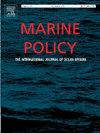国际海事组织白令海峡船舶航行“避开区域”政策有效性分析(2015-2022年)
IF 3.7
2区 社会学
Q2 ENVIRONMENTAL STUDIES
引用次数: 0
摘要
每年都有大量的货船和油轮通过白令海,随着北极海冰的减少,通过白令海峡前往新航线的旅行水平不断增加是当代的现实。该地区航运的增加不仅加剧了对偏远社区的影响,而且引起了对船舶操作员安全和环境的关注。分析白令海的现有政策有助于确定政策的有效性,因为该地区的海上活动正在扩大。为了研究2015年至2022年交通模式的变化,以及现有政策的有效性,研究人员对白令海峡“避开区域”(ATBAs)进行了热点分析(Getis-Ord Gi*),该分析于2018年作为国际海事组织极地规则的一部分实施。此外,对每年(8年中的8年)、频繁(4-7年)或很少(1-3年)通过该地区的船只进行热点分析(Getis-Ord Gi*),以调查可能影响遵守ATBA政策的海上活动方面。对2015年至2022年白令海峡船舶交通的分析表明,ATBA政策影响了所有类型的船舶。确定当前白令海峡海上活动政策的有效性,对于未来制定政策以保护阿拉斯加这一独特地区以及在有历史记载之前居住在该地区的社区是必要的。本文章由计算机程序翻译,如有差异,请以英文原文为准。
Analysis on the effectiveness of International Maritime Organization’s ‘Areas to be Avoided’ policy on vessel traffic in the Bering Strait (2015–2022)
Numerous cargo and tanker vessels every year transit the Bering Sea, and with decreasing sea ice in the Arctic, increasing levels of travel through the Bering Strait to new shipping routes is a contemporary reality. Increased shipping in the region not only intensifies the impact to remote communities but also causes concern for the safety of vessel operators and the environment. Analyzing existing policy within the Bering Sea is useful to determine policy effectiveness as maritime activity is amplified in the region. To examine changes in traffic patterns from 2015 to 2022, and therefore the effectiveness of existing policy, hot spot analysis (Getis-Ord Gi*) was conducted on the Bering Strait ‘Areas to be Avoided’ (ATBAs), implemented in 2018 as a part of the International Maritime Organization’s Polar Code. Additionally, hot spot analysis (Getis-Ord Gi*) was conducted on vessels transiting the region every year (8 of 8 years), frequently (4–7 years), or rarely (1–3 years) to investigate aspects of maritime activity that can impact adherence to the ATBA policy. The analysis conducted on vessel traffic in the Bering Strait from 2015 through 2022 shows that the ATBA policy influenced all vessel types. Determining the effectiveness of current policy in maritime activity in the Bering Strait will be necessary for future policymaking to protect this unique region of Alaska, as well as for the communities who have inhabited it before recorded history.
求助全文
通过发布文献求助,成功后即可免费获取论文全文。
去求助
来源期刊

Marine Policy
Multiple-
CiteScore
7.60
自引率
13.20%
发文量
428
期刊介绍:
Marine Policy is the leading journal of ocean policy studies. It offers researchers, analysts and policy makers a unique combination of analyses in the principal social science disciplines relevant to the formulation of marine policy. Major articles are contributed by specialists in marine affairs, including marine economists and marine resource managers, political scientists, marine scientists, international lawyers, geographers and anthropologists. Drawing on their expertise and research, the journal covers: international, regional and national marine policies; institutional arrangements for the management and regulation of marine activities, including fisheries and shipping; conflict resolution; marine pollution and environment; conservation and use of marine resources. Regular features of Marine Policy include research reports, conference reports and reports on current developments to keep readers up-to-date with the latest developments and research in ocean affairs.
 求助内容:
求助内容: 应助结果提醒方式:
应助结果提醒方式:


